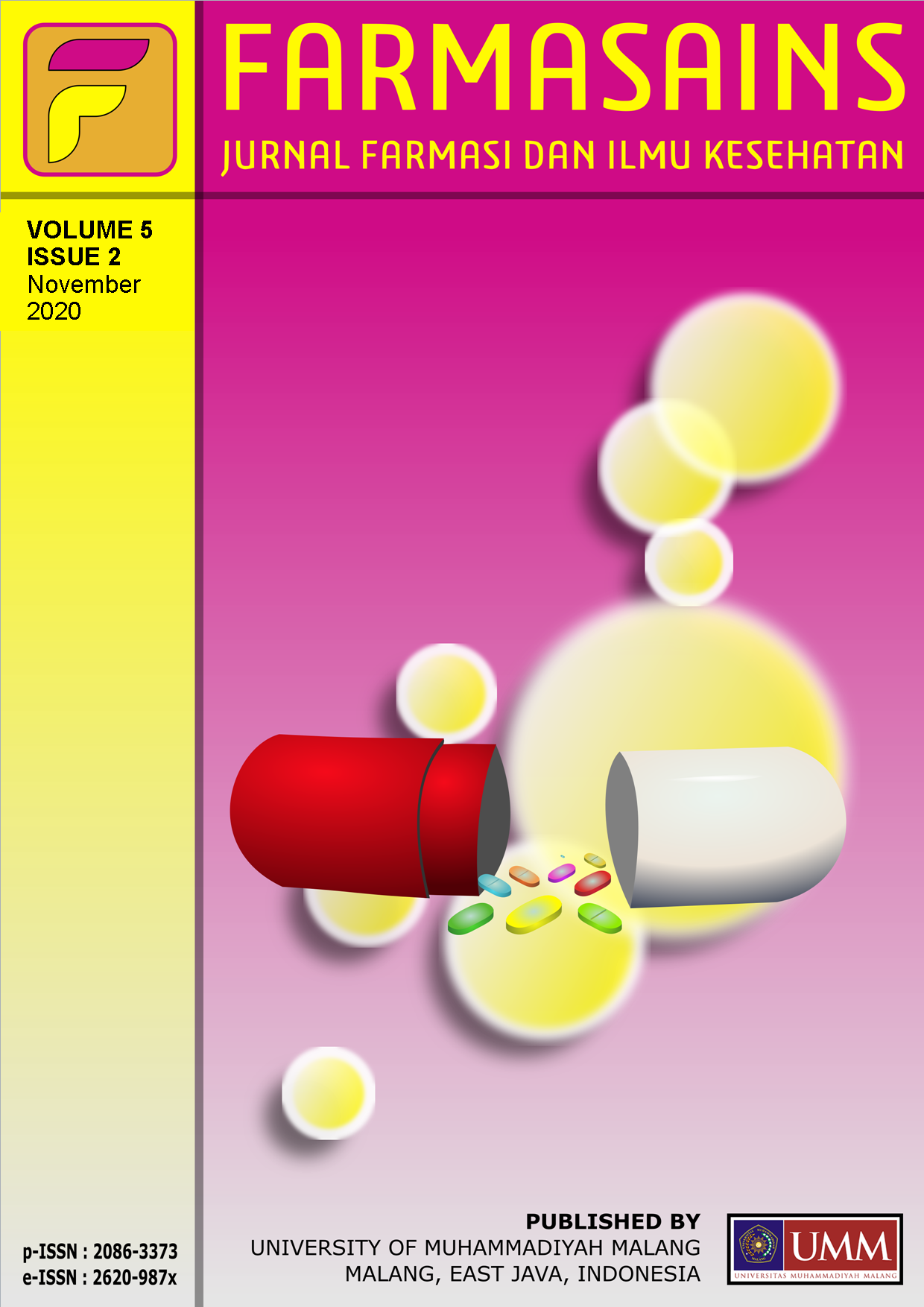Analysis of the effect of tofu industrial waste on dug well water quality
DOI:
https://doi.org/10.22219/farmasains.v5i2.13298Keywords:
Tofu waste, dug well water, Lautingara, BOD, CODAbstract
The industrial tofu factory located in Lautingara Kelurahan Kalabahi Tengah, where the remaining liquid waste is channeled directly into the reservoir without prior treatment, can affect water quality in the dug wells. The purpose of this study was to determine the quality and feasibility of dug well water as drinking water-based on parameters of pH, BOD, COD, nitrite, and nitrate of dug well water, which is suspected to be contaminated by the presence of tofu waste. The results showed that the pH value and nitrite value (NO2-) of the three dug well water samples in Lautingara met the drinking water quality standards, while the BOD, COD, and nitrate (NO3-) values in the three dug well water samples in Lautingara did not meet the values quality standards and not suitable for drinking water.
Downloads
References
Atima, W. (2015). BOD dan COD sebagai parameter pencemaran air dan baku mutu air limbah. BIOSEL (Biology Science and Education): Jurnal Penelitian Science dan Pendidikan, 4(1), 83-93. doi:10.33477/bs.v4i1.532
Badan Standardisasi Nasional. (2004). Cara UJi Nitrit (NO2-N), Secara Spektrofotometri, SNI 06-6989.9-2004. Jakarta, Indonesia: Authors.
Badan Standardisasi Nasional. (2009). Chemical Oxygen Demand (COD), Dengan Refluks Tertutup Secara Spektofotometri, SNI 6989.2:2009. Jakarta, Indonesia: Authors.
Balaji, R., Sasikala, S., & Muthuraman, G. (2014). Removal of Iron from drinking / ground water by using agricultural Waste as Natural adsorbents. International Journal of Engineering and Innovative Technology, 3(12), 43-46.
Barakat, M, A. (2011). New trends in removing heavy metals from industrial wastewater. Arabian Journal of Chemistry, 4(4), 361-377. doi:10.1016/j.arabjc.2010.07.019
Botahala, L. (2019). Perbandingan Efektivitas Daya Adsorpsi Sekam Padi Dan Cangkang Kemiri terhadap Logam Besi (Fe) pada Air Sumur Gali. Sleman, Indonesia: Deepublish Publisher.
Botahala, L., Zakir, M., Patarru, O., & Yasser, M. (2018). Comparison of the effectiveness of the adsorption power of risk husk and the hazelnut shell of the ferrous metal. Embodying The Global Maritime Axis. Proceedings of the 1st International Proceeding Building Synergy on Diversity in The Borders. Alor, Indonesia.
Emilia, I. (2019). Analisa kandungan Nitrat dan Nitrit Dalam Air Minum Isi Ulang menggunakan Metode Spektrofotometri UV-Vis. Indobiosains, 1(1), 38-44. doi:10.31851/INDOBIOSAINS.V1I1.2441
Gunatilake, S, K. (2015). Methods of Removing Heavy Metals from Industrial Wastewater. Journal of Multidisciplinary Engineering Science Studies, 1(1), 12-18.
Karbeka, M., Botahala, L., & Duka, P. (2020). Analysis of mineral content in Hotspring Water samples in Tubbe and Aramaba Village, Pantar Tengah District, Alor-NTT. IOP Conference Series: Materials Science and Engineering, 823(1), p. 012051. doi: 10.1088/1757-899X/823/1/012051
Loganathan, P., Vigneswaran, S., & Kandasamy, J. (2013). Enhanced removal of nitrate from water using surface modification of adsorbents–a review. Journal of environmental management, 131, 363-374. doi:10.1016/j.jenvman.2013.09.034
Manurung, J. (2009). Studi Efek Jenis Dan Berat Koagulan Terhadap Penurunan Nilai COD Dan BOD Pada Pengolahan Air Limbah Dengan Cara Koagulasi. (Undergraduate’s Thesis). Universitas Sumatera Utara, Medan, Indonesia.
Peraturan Menteri Kesehatan Republik Indonesia No. 32. (2017). Kesehatan lingkungan untuk media air untuk keperluan higienis sanitasi. Retrieved from https://www.hukumonline.com/pusatdata/detail/lt596ece86e5a42/node/lt50ed11b73a96d/peraturan-menteri-kesehatan-no-32-tahun-2017-standar-baku-mutu-kesehatan-lingkungan-dan-persyaratan-kesehatan-air-untuk-keperluan-higiene-sanitasi,-kolam-renang,-solus-per-a
Peraturan Pemerintah No. 82. (2001). Pengelolaan Kualitas Air Dan Pengendalian Pencemaran Air. Retrieved from https://peraturan.bpk.go.id/Home/Details/53103/pp-no-82-tahun-2001
Ratnani, R. D. (2012). Kemampuan kombinasi eceng gondok dan lumpur aktif untuk menurunkan pencemaran pada limbah cair industri tahu. Majalah Ilmiah Momentum, 8(2), 1-5. doi:10.36499/jim.v8i2.434
Rivai, A., Syamsinar, N. (2017). Hubungan kandungan nitrat (NO3) dan nitrit (NO2) pada air lindi dengan kualitas air sumur gali di Kel. Bangkala Kec. Manggala Kota Makassar tahun 2017. Jurnal Sulolipu: Media Komunikasi Sivitas Akademika Dan Masyarakat, 17(2), 1-10. doi:10.32382/sulolipu.v17i2.791
Sasono, E., & Asmara, P. (2013). Penurunan Kadar BOD dan COD Air Limbah UPT Puskesmas Janti Kota Malang dengan Metode Contructed Wetland. WAKTU: Jurnal Teknik UNIPA, 11(1), 60-70.
Siswoyo, E., & Hermana, J. (2017). Pengaruh Air Limbah Industri Tahu terhadap Laju Pertumbuhan Tanaman Bayam Cabut (Amaranthus tricolor). Jurnal Sains Dan Teknologi Lingkungan, 9(2), 105-113. doi:10.20885/jstl.vol9.iss2.art4
Tripathi, A., & Ranjan, M, R. (2015). Heavy Metal Removal from Wastewater Using Low Cost Adsorbents. Bioremediation & Biodegradation, 6(6), 315. doi:10.4172/2155-6199.1000315
Downloads
Published
How to Cite
Issue
Section
License
Copyright (c) 2021 Sara Antoneta Atakari, Zakarias Mautuka, Martasiana Karbeka, Loth Botahala

This work is licensed under a Creative Commons Attribution 4.0 International License.
Authors who publish with this journal agree to the following terms:
a. Authors retain copyright and grant the journal right of first publication with the work simultaneously licensed under a Creative Commons Attribution License that allows others to share the work with an acknowledgement of the work's authorship and initial publication in this journal.
b. Authors are able to enter into separate, additional contractual arrangements for the non-exclusive distribution of the journal's published version of the work (e.g., post it to an institutional repository or publish it in a book), with an acknowledgement of its initial publication in this journal.
c. Authors are permitted and encouraged to post their work online (e.g., in institutional repositories or on their website) prior to and during the submission process, as it can lead to productive exchanges, as well as earlier and greater citation of published work (See The Effect of Open Access).













